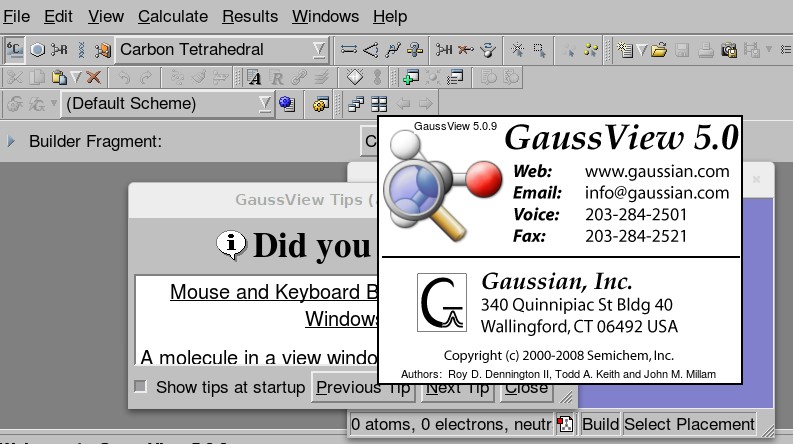JUSTUS2/Software/Gaussview
|
The main documentation is available on the cluster via |
| Description | Content |
|---|---|
| module load | chem/gaussview |
| License | Commercial - see Pricing for Gaussian Products |
| Citing | See section Citation of the Release Notes |
| Links | Gaussian Homepage; GaussView Documentation |
| Graphical Interface | Yes |
| Related program | See Gaussian |
Description
GaussView is an advanced and powerful graphical user interface for Gaussian. With the aid of GaussView you can
- build, save or load molecular structures (advanced molecule editor)
- prepare Gaussian calculations (create and save Gaussian input files with all parameters)
- monitor progress of running Gaussian calculations (login to the compute node and change to the temporary job directory)
- load, view and analyze results (e.g. visualize 3D ISO surfaces of densities and orbitals, plot IR and Raman spectra)
- setup, visualize and analyze parameter scans
- setup QM/MM calculations
For more information on features please visit GaussView's GaussView Documentation web page.
Usage
There are two methods to start GaussView remotely on JUSTUS 2:
- Remote-VNC method (recommended): First set up a VNC (Virtual Network Computing) remote desktop connection to one of the JUSTUS 2 login or visualization nodes. To help you with that we have pre-installed TigerVNC on JUSTUS 2. See the TigerVNC documentation for details. Thereafter you can open a terminal window in that VNC session, load the GaussView module and start GaussView via command gaussview.
- X-forwarding method (usually slow): First log in to the JUSTUS 2 login or visualization nodes with X-forwarding enabled (i.e. ssh -X). Then load the GaussView module and start GaussView via command gaussview. Major disadvantage: X-forwarding requires a very fast network connection with low latency. Usually home or Wi-Fi networks are too slow.
NEVER start long running large calculations interactively on login or visualization nodes. Use GaussView to prepare and save the input. Then submit a Gaussian job with the input created by GaussView.
Parallel computing
One can construct/save or start serial as well as parallel jobs with GaussView. To switch from serial to parallel one has to modify entry Shared Processors within Gaussian Calculation Setup window.
Please make sure that the speed up of the calculation is reasonable when requesting more cores. When doubling the number of cores, the speed up should be at least a factor 1.7, better 1.8.
Please keep in mind that our Gaussian version is only shared-memory parallel. Therefore requesting more than one node does not make any sense.
Loading the module and starting GaussView (within VNC session)
The best method to use GaussView is to start it within an interactive
remote VNC session or a (Linux-)System with X-forwarding (e.g.: ssh -X 'your-id'@FQDN-of-cluster.de).
Details on how to start an interactive VNC session running on a compute node can be found here: TigerVNC
Within the X11 session open a terminal window (e.g. xterm) and execute:
$ module load chem/gaussview gaussview &
The GaussView module automatically loads the corresponding Gaussian module.

See GaussView example session for more infos how to work with the GUI.
It is recommended to always specify the full module name including
the version of the module, e.g. specify
$ module load chem/gaussview/6.1.1
to load version 6.1.1 of GaussView.
Starting Gaussian jobs interactively via GaussView
Within the interactive VNC session running on a compute node you may start Gaussian jobs locally via Submit or Quick Launch. These buttons are located within the Gaussian Calculation Setup window of GaussView.
If you do so you must make sure that these jobs finish before the run time of the interactive VNC session ends. Furthermore your should never occupy more cores (GaussView setting Shared Processors, default 1 core) than specified when submitting the VNC session (Slurm option --ntasks-per-node, default 1 core). Finally be aware that your job might get killed if it uses more memory than requested.
Submitting Gaussian jobs to the queueing system
First you can construct your Gaussian job interactively with GaussView. When done with setting up of the job, save the Gaussian command file to disk and submit that *.com file as described in the documentation of Gaussian. Please read the Gaussian documentation as well and make sure that you specify reasonable values for the number of cores, memory usage, disk usage and job run time when submitting the job.
Examples
GaussView example session
- When 'gaussview' is started, the 'Builder Fragment' of the programs main window (gray background) displays the 'Carbon Tetrahedral' by default.
- Click in the middle of the construction window (blue background). The selected fragment should now be displayed there (undo clicks via 'Menu: Edit -> Undo').
- Start a Gaussian calculation 'Menu: Calculate -> Gaussian Calculation Setup'. Keep all defaults and hit 'Button: Quick Launch' at the bottom.
- View the results via 'Menu: Results -> Summary'.
- Create orbital contour plots via 'Menu: Results -> Surface/Contours', 'Button: Cube Actions -> New Cube', 'Button: Surface Actions -> New Surface'. If you have accepted all defaults, you should see the HOMO orbital now.